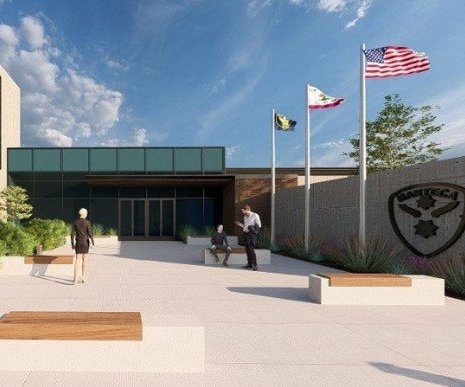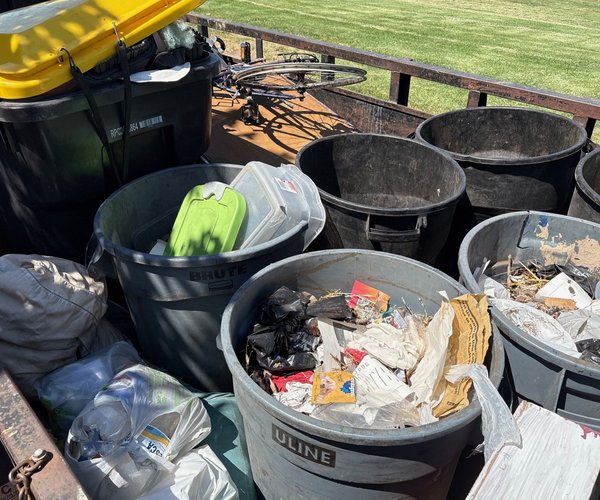It’s expected to reach 103 degrees today.
The worsening drought — now deep in its third year — is forcing the Manteca City Council to declare a water emergency when they meet tonight at 7 p.m.
That will trigger a mandatory 20 percent reduction in water use citywide in a bid to weather the drought.
The first to go will be ornamental grass/turf at commercial, industrial and institutional facilities (churches, schools, hospitals, government buildings) that will not be allowed to be irrigated using portable water.
On the same agenda the City Council is expected to sign off on Manteca’s portion of a property tax diversion plan to improve protection against “200-year floods” — a shorthand referencing devastating flooding events that have a 1-in-200 chance of occurring in any given year.
When it comes to feast or famine involving water, perhaps no place else in California is in such a precarious situation as Manteca and Lathrop.
The Stanislaus River watershed rights held by the South San Joaquin Irrigation District that serves the two cities along with Tracy as well as farmers producing crops on 50,000 acres is under attack to allow increased water flow for fish to take pressure off other watershed diversions that keep water flowing to the Los Angeles Basin and large corporate farm interests.
At the same time Manteca and Lathrop being on the southeast corner of the Delta where the San Joaquin enters it just after being joined by the Stanislaus River has no bypass in place such as that protecting Sacramento from flooding events on the Sacramento River.
Development along with climate change are also working in tandem to increase the frequency and size of flood events.
Drought models show a change in precipitation overall may drop but with a caveat. Warmer rains are likely to mean earlier melting of what snowpack there is during the rainy season.
The result is Manteca has to address flooding even when drought is threatening public safety and health.
The incremental property tax diversion will involve only property in Manteca within the 200-year-flood zone. It also involves all of Lathrop outside of River Islands which already has upgraded protection as well as the Weston Ranch portion of Stockton, French Camp and various rural areas.
Because it is a diversion of incremental tax, it does not involve a new property tax.
It is part of a plan involving the cities of Manteca, Lathrop, and Stockton, along with San Joaquin County to generate $270 million for the locally-funded levee enhancements meet mandated flood protect requires spelled out in California Senate Bill 5.
How the diversion impacts
City of Manteca finances
The 5,157 homes plus 11 million square feet of business parks and retail space Manteca hopes to still build in the 200-year floodplain will have the municipal general fund awash in money.
At least that’s what the conclusion of the consultant analyzing diverting future property tax revenue from the city’s general fund to help defray the cost of bonds.
The analysis — conducted on behalf of the San Joaquin Area Flood Control Agency — involves diverting up to 20 percent of all incremental property tax increases that would go to the city in the impacted area to help retire bonds over a 30-year period.
Manteca — just like other California cities — only receives a sliver of every dollar that homeowners and others pay in property taxes. The rest goes to 10 other agencies including schools at 51 percent followed in diminishing slices by San Joaquin County, and Delta College among others.
The sliver Manteca receives varies from 7 to 14 percent depending upon the year property was — or is — annexed to the city. The drop in the percentage cities receive in property taxes have been imposed by counties throughout the state that allow land to be annexed to municipalities.
In the case of Manteca, SJAFCA’s financial consultant ran models characterized as “conservative”.
The consultant determined when every home and square foot of commercial and business parks the city can squeeze in along much of the Airport Way corridor and a large swath of southwest Manteca:
*Up to 20 percent of the city’s share of property tax in the impacted area could be diverted to pay off bonds needed for flood protection work.
*At the same time, Manteca could maintain the current level of municipal staffing such as the number of workers including the current police to population ratio as well as the current conditions of streets, parks, and other general fund expenditures.
*End up with $14.2 million “extra” annually in the general fund from property taxes from the impacted area after money is siphoned off to retire bonds and spent to maintain the current level of services.
The property tax that would be diverted would be up to 20 percent of the annual incremental basis.
If 2023 becomes the base year, the cities involved — Lathrop, Stockton and Manteca — as well as San Joaquin City — would keep 100 percent of their pre-2023 cut of the property tax.
After that 20 percent of increases whether it is from new construction, the maximum 2 percent annual rise in property assessment allowed under Proposition 13 for homes and such that have not sold, and the readjustment to market value when homes do sell would go to the flood agency to retire bonds.
The biggest gain in property assessment over the long-haul would come from homes reselling. Typically, Americans sell their homes on an average of every eight years according to the National Association of Realtors. In California, the churn is closer to five years.
A development fee is already in place for new construction. In the areas in Manteca within the 200-year flood zone that fee comes to:
*$3,148 per single family home.
*$904 per unit for multiple family construction such as apartment complexes.
*$1,417 per 1,000 feet of commercial.
*$1,096 per 1,000 feet of industrial (business parks).
At built out new construction the affected area in Manteca is projected to generate $26.9 million toward funding the flood control project.
A third financing tool is a proposed financial overlay district that would be a new tax on all property within the Mossdale Tract.
To contact Dennis Wyatt, email dwyatt@mantecabulletin.com






